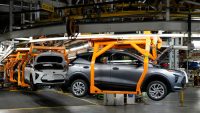A LATE-NIGHT journey back from the pub is always the best place to start for column fodder.
After our usual musing that we should move into the vacant lot on the roundabout near our office, set up our own car dealership and write about it for the pages of this magazine, Lord Baggott chimed in with a popular (or possibly unpopular) theory.
He was adamant – after a few pints, I’ll add – that today you don’t need a pitch at all. If your website is good enough, then you don’t even need to entertain the sales you might make from passing trade.
That’s all well and good, I said, but would everyone trust a dealer who tells them to meet them on an industrial estate at a certain time where they will let them view a car? And how many people don’t want the pressure of an appointment when they’re only in the very early stages of car shopping?
‘Who doesn’t look online when they’re buying a car these days? Seriously, who would buy a car without at least looking online first?’ garbled our illustrious leader.
It’s true, I thought. Despite the beer, wine and three types of cocktails that had passed his lips that evening, the man was talking sense.
People don’t just see a car, walk in and buy it there and then any more, surely?
Building trust
Even though I don’t want to buy anything unless it can arrive in a box four times its size with enough space for me to live in (if it wasn’t filled with plastic packaging), and for free thanks to my Amazon Prime membership, I still found myself wanting to disagree.
For me, a forecourt is an important part of marketing a car, or at least the dealership itself, and building trust with customers.
Despite my penchant for old cars and distaste for anything practical, there have been several times I’ve passed a Ford or Skoda franchise and my eye has been caught by the monthly deals on some of their cars.
Of course, I’ve had to Google the unbelievable offer immediately after. That’s then taken me to a completely different dealer’s website and I’ve still not bought the car – but it’s the thought that counts, right?
‘A lot of people want to go and snoop around the car on the forecourt without having the pressure of actually talking to a salesman,’ says the sober angel to my right, Jon Reay, who was taking us on a tour of Gosport to get home. From the back seat, Baggott came back to life, having momentarily started to snooze.
‘It would have to be something pretty special to catch your eye, though. I’m talking about the times when you’d be out on a Saturday, see a car parked on the forecourt with balloons and all, then go in because you actually wanted to buy it.’
It’s got to be a balance, though, retorted Jon and I. There are plenty of businesses out there with no roadside presence but a spectacular website to compensate.
And you know what they do very well? They build into their website every element of a car dealership that helps to sell cars. If you want to meet the sales team, you can see them, read about them or even watch videos from them, then follow them on Twitter, email or call them.
If you want to see where you’re going, many of the best dealerships out there have several photos of their sites, while some also use Google Maps’ Business View to give a 360-degree view of their showrooms, or even host video tours on their websites.
Why would you need to sneak around a forecourt after hours if you could see every angle and element of the car online?
Those barriers we talked about are being broken down. You might be going to an industrial estate in Milton Keynes next to a warehouse distributing gardening gloves, but the customer knows that when they arrive it’ll be a legitimate business.
Only one question from me remains: ‘How do I find that business in the first place, though?’
Why would I search for Bill’s BMWs and end up on its website rather than Matt’s M-Sport Emporium – or do we just accept now that being higher up on Google or promoted in someone’s feed is the only way to attract that passing trade?
Maybe we just need to accept that every buyer is different.
It’s fair to say that in this difficult economic climate, no-one should be writing off ways to sell cars, but adding expense for very little isn’t the way forward either.
‘Ouch!’ says Baggott, as we crash over a really big bump as he’d fallen asleep.
Maybe midnight isn’t the best time to start arguing about how to sell cars, but one thing’s for sure: it’s far better than talking about Brexit.
Rebecca Chaplin is head of editorial at Blackball Media and presents news programmes and features on its online video channel Trade Plates TV.
MORE: Suzuki tops What Car? Reliability Survey 2018
MORE: Dealers missing out on sales by failing to send email replies
MORE: Coming soon: UK’s first Polestar Space retail environment


































